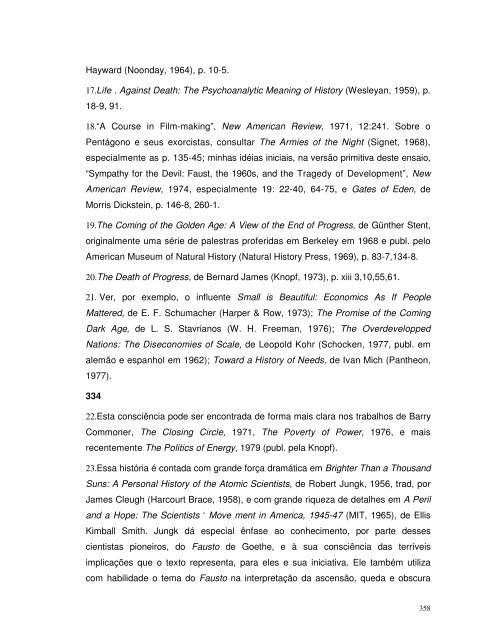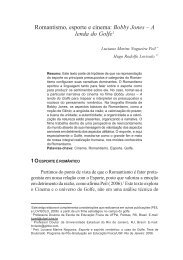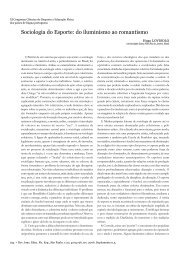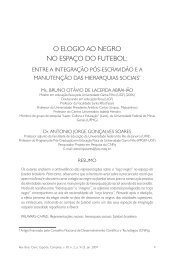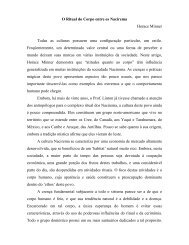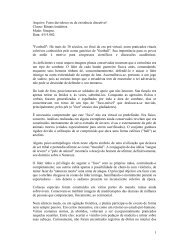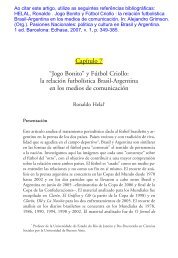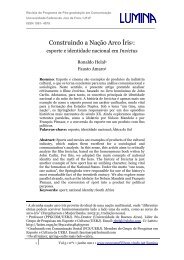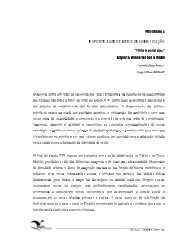- Page 1 and 2:
MARSHALL BERMAN TUDO QUE É SÓLIDO
- Page 3 and 4:
Copyright © 1982 Marshall Berman P
- Page 5 and 6:
V. Na Floresta dos Símbolos: Algum
- Page 7 and 8:
PREFÁCIO Durante a maior parte da
- Page 9 and 10:
Introdução MODERNIDADE ONTEM, HOJ
- Page 11 and 12:
No século XX, nossa terceira e úl
- Page 13 and 14:
XIX atacam esse ambiente, com paix
- Page 15 and 16:
A burguesia não pode sobreviver se
- Page 17 and 18:
o fato de que o homem moderno “ja
- Page 19 and 20:
transformado pelo homem moderno. Vi
- Page 21 and 22:
25 desenvolveram a fim de exportar
- Page 23 and 24:
perspectiva neo-olímpica de Weber
- Page 25 and 26:
elamente configurada e perfeitament
- Page 27 and 28:
Cage aceitou a subvenção do xá d
- Page 29 and 30:
a liberdade para a moderna humanida
- Page 31 and 32:
Marx, Nietzsche e seus contemporân
- Page 33 and 34:
Desde que se começou a pensar em u
- Page 35 and 36:
o processo pelo qual, no fim do sé
- Page 37 and 38:
sequer chegou a viver. O que leva F
- Page 39 and 40:
essonância especial em países soc
- Page 41 and 42:
momentos de sol. Fausto acompanha a
- Page 43 and 44:
É nesse exato momento — para des
- Page 45 and 46:
necessário), todavia a acumulaçã
- Page 47 and 48:
uma tragédia, do desenvolvimento.
- Page 49 and 50:
E nessa prisão, ah, que arrebatame
- Page 51 and 52:
conseqüências humanas de sua pró
- Page 53 and 54:
julgada como assassina e condenada
- Page 55 and 56:
interminável, sem descanso. Gretch
- Page 57 and 58:
TERCEIRA METAMORFOSE: O FOMENTADOR
- Page 59 and 60:
partir de uma terra desolada e impr
- Page 61 and 62:
parecem usar as mesmas pás e enxad
- Page 63 and 64:
ajudou a se tornarem o que são —
- Page 65 and 66:
mãos e condena o exécutante da ta
- Page 67 and 68:
mundo, não lhe resta mais nada a f
- Page 69 and 70:
claramente não-capitalistas. O Mef
- Page 71 and 72:
transporte em escala internacional.
- Page 73 and 74:
— “os sacrifícios humanos sang
- Page 75 and 76:
Faustos do Terceiro Mundo, em apena
- Page 77 and 78:
encontrar a satisfação e dizer:
- Page 79 and 80:
cantando, dançando, fazendo amor e
- Page 81 and 82:
emerge quando Fausto é deslocado d
- Page 83 and 84:
impulso fáustico na direção do d
- Page 85 and 86:
II TUDO O QUE É SÓLIDO DESMANCHA
- Page 87 and 88:
No entanto, quanto mais perto chega
- Page 89 and 90:
egionais que toca. Produção e con
- Page 91 and 92:
movimentos de pessoas — para cida
- Page 93 and 94:
pode subsistir sem constantemente r
- Page 95 and 96:
dos seus pés, em que a burguesia p
- Page 97 and 98:
capitalista, de Adam Ferguson a Mil
- Page 99 and 100:
muito mais vasta do que os modernos
- Page 101 and 102:
voláteis, explosivas, em fontes de
- Page 103 and 104:
Ainda que os trabalhadores de fato
- Page 105 and 106:
Nesse momento emerge um novo simbol
- Page 107 and 108:
uniforme e ilusório véu de polide
- Page 109 and 110:
sequer em marcha. Marx acredita que
- Page 111 and 112:
movimentos niilistas, a burguesia a
- Page 113 and 114:
mesmo tempo, despertados pelo comun
- Page 115 and 116:
especialmente interessante porque,
- Page 117 and 118:
É fácil ver como os modernos inte
- Page 119 and 120:
transcendência é exigir e lutar p
- Page 121 and 122:
ortodoxos, que evitam o pensamento
- Page 123 and 124:
às vezes como dogma, às vezes com
- Page 125 and 126:
descortinam são relevantes hoje, c
- Page 127 and 128:
desenvolvidos? Eles talvez partilhe
- Page 129 and 130:
III BAUDELAIRE: O MODERNISMO NAS RU
- Page 131 and 132:
um herói”. 1 O poeta Theodore de
- Page 133 and 134:
política, que luta, corajosa, com
- Page 135 and 136:
Caso isso seja, como quer Baudelair
- Page 137 and 138:
de polícia espiritual a serviço d
- Page 139 and 140:
artista (ou quem quer que seja) son
- Page 141 and 142:
gravatas e em nossas botas de couro
- Page 143 and 144:
arrebatadoras, muito longe da pasto
- Page 145 and 146:
filme, mas sem dúvida teria confer
- Page 147 and 148:
o interior decorado, iluminado pela
- Page 149 and 150:
após séculos de vida claustral, e
- Page 151 and 152:
esponsáveis pela demolição e rec
- Page 153 and 154:
sociais — que os bulevares trouxe
- Page 155 and 156:
familiarizados com Marx notarão a
- Page 157 and 158:
carruagem ou caminhar sobre pernas
- Page 159 and 160:
degradação, tudo quanto seja abom
- Page 161 and 162:
de pureza espiritual, ele também t
- Page 163 and 164:
confrontos e colisões serão evita
- Page 165 and 166:
da vida moderna cotidiana, o homem
- Page 167 and 168:
triunfo ajudou a destruir a verdade
- Page 169 and 170:
Entretanto, têm surgido pessoas em
- Page 171 and 172:
Estive em Paris e Londres (...) nã
- Page 173 and 174:
emergente Terceiro Mundo do século
- Page 175 and 176:
construir em escala tão vasta. No
- Page 177 and 178:
político secular — para apodrece
- Page 179 and 180:
urgo uma cidade. Á tentativa, é c
- Page 181 and 182:
granito, a renda de grades de ferro
- Page 183 and 184:
filhos. (...) E assim viveremos e
- Page 185 and 186:
corpos retorcidos; chega ao local,
- Page 187 and 188:
governantes; a visão dos sucessore
- Page 189 and 190:
Alexander Herzen, escrevendo no ex
- Page 191 and 192:
tinha verdadeiramente sentido. Essa
- Page 193 and 194:
série de litografias da década de
- Page 195 and 196:
Quão limpas suas calçadas, e quan
- Page 197 and 198:
por necessidades reais diretas e in
- Page 199 and 200:
quarto e corta a garganta. Qual é
- Page 201 and 202:
duas narrativas que se seguem. As h
- Page 203 and 204:
dominado pelo Cavaleiro de Bronze,
- Page 205 and 206:
pobre deverá encontrar sua voz. O
- Page 207 and 208:
Ainda que Devushkin quisesse, simpl
- Page 209 and 210:
201 “Cumprimento-o ou não? Mostr
- Page 211 and 212:
modificada. Todavia, a amargura que
- Page 213 and 214:
crescido na década seguinte. Outro
- Page 215 and 216:
estudante) esfarrapado (após ter d
- Page 217 and 218:
epresenta os plebeus de Petersburgo
- Page 219 and 220:
do Subterrâneo. Sem Chemyshevski,
- Page 221 and 222:
Dostoievski revela essa ambivalênc
- Page 223 and 224:
aquilo que o manifesto À Geração
- Page 225 and 226:
não era isso o que importava. O qu
- Page 227 and 228:
Os bulevares parisienses de Haussma
- Page 229 and 230:
subterrâneo, e uma antiga classe d
- Page 231 and 232:
221 lugar pequeno no vasto espaço
- Page 233 and 234:
EPÍLOGO: O PALÁCIO DE CRISTAL, FA
- Page 235 and 236:
ousada de todo o século XIX. Apena
- Page 237 and 238:
Bücher continua: podemos saber se
- Page 239 and 240:
um animal criador por excelência,
- Page 241 and 242:
paredes deslizantes (para facilitar
- Page 243 and 244:
subúrbios e regiões fora dos limi
- Page 245 and 246:
nostálgica da “avenida de seus d
- Page 247 and 248:
estamos sendo empurrados mais e mai
- Page 249 and 250:
uma visão daquilo que uma verdadei
- Page 251 and 252:
pressionaram o governo a fazer um g
- Page 253 and 254:
enquanto os pontos, vírgulas, pont
- Page 255 and 256:
243 composição da miriápode se t
- Page 257 and 258:
atentados contra suas vidas, inclus
- Page 259 and 260:
“De quem?” “Dele.” Eles se
- Page 261 and 262:
multi-distinção de palavras. Toda
- Page 263 and 264:
“Certamente, um modernista a cham
- Page 265 and 266:
se usar o argumento de que outubro
- Page 267 and 268:
MANDELSTAM: A PALAVRA ABENÇOADA SE
- Page 269 and 270:
Durante toda a sua vida, Mandelstam
- Page 271 and 272:
Mandelstam capta o drama e a angús
- Page 273 and 274:
assuntos mais elevados.” (II, 156
- Page 275 and 276:
ligado para Proserpina ou Perséfon
- Page 277 and 278:
encapotados, com luvas que tinham s
- Page 279 and 280:
muitos mais, Mandelstam compôs um
- Page 281 and 282:
e mensagens que a Rússia precisa u
- Page 283 and 284:
Nova Delhi, Cidade do México — n
- Page 285 and 286:
esultado é niilismo!” (Do discur
- Page 287 and 288:
pois seus símbolos e simbolismos e
- Page 289 and 290:
horríveis para aqueles que relembr
- Page 291 and 292:
último ato de Fausto de Goethe. (
- Page 293 and 294:
enovação e a reforma, com a perp
- Page 295 and 296:
inacessível e desconhecido, até q
- Page 297 and 298:
propriedades que Scott Fitzgerald i
- Page 299 and 300:
mas compreendeu o valor das crescen
- Page 301 and 302:
ealizações de Moses como seu clí
- Page 303 and 304:
Foi com esta marca — com sua fé
- Page 305 and 306:
tribunais que nenhum governo tinha
- Page 307 and 308: mais dramático de algo que estava
- Page 309 and 310: omances mais ricos e profundos da d
- Page 311 and 312: Quando meus amigos e eu descobrimos
- Page 313 and 314: Antes que os Molochs do mundo moder
- Page 315 and 316: possível que experimentemos uma se
- Page 317 and 318: que sempre servira à expressão da
- Page 319 and 320: uma arte que seria, como disse Alle
- Page 321 and 322: imagens e sons “político-erótic
- Page 323 and 324: 1960, raras eram as palavras mais a
- Page 325 and 326: WPA ou de uma versão hoUywoodiana
- Page 327 and 328: avançando pelas ruas do Norte, mar
- Page 329 and 330: amigos e eu estávamos tramando qua
- Page 331 and 332: do Vietnã podia ser em grande part
- Page 333 and 334: Durante toda a década de 60, a que
- Page 335 and 336: mundo, sugeriram que, quaisquer que
- Page 337 and 338: entrevistas gravadas com seu pai, s
- Page 339 and 340: início e em meados dos anos 60, um
- Page 341 and 342: adorável flor branca no final do v
- Page 343 and 344: novas afirmações; sem esse quadro
- Page 345 and 346: mais corrompido, ou ambas as coisas
- Page 347 and 348: 327 na face voltada para o nascente
- Page 349 and 350: visão mais ampla ou de esperança
- Page 351 and 352: NOTAS INTRODUÇÃO: MODERNIDADE —
- Page 353 and 354: Jonathan Cape, 1967), p. 58. Associ
- Page 355 and 356: Fall of the (American) Avant-Garde
- Page 357: do livro de Schachtel, Metamorphosi
- Page 361 and 362: o ser humano aparece como a finalid
- Page 363 and 364: 88. Os temas do século XVIII esbo
- Page 365 and 366: adicionais, próximas daquelas apre
- Page 367 and 368: similar àquela aqui apresentada. 9
- Page 369 and 370: vezes utilizei traduções minhas,
- Page 371 and 372: sobre estagnação, retrocesso e re
- Page 373 and 374: em Dostoevsky’s Occasional Writin
- Page 375 and 376: 30.Citado por Lampert, em Sons Agai
- Page 377 and 378: eve e incisivo relato das complexid
- Page 379 and 380: Lukács fará alguns anos mais tard
- Page 381 and 382: 62.Trad. Clarence Brown em Prose of
- Page 383 and 384: Corporations (MIT, 1978), de Annema
- Page 385: FIM DO LIVRO 385


